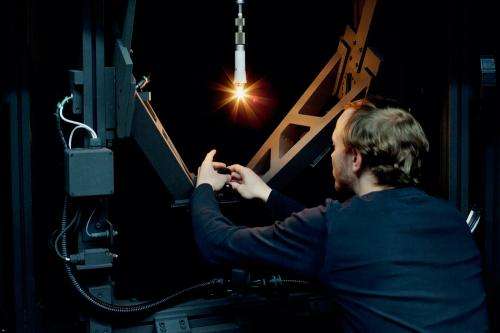Well-tempered lighting: Emitting much more light for less electric-power dissipation

Scenarios for the optimal employment of light-emitting diodes for lighting purposes are being investigated at the TU Darmstadt's Institute for Lighting Technology. The focus is on human perceptions, wellbeing, and health.
Light-emitting diodes (LEDs) have already become commonplace outdoors in the form of automobile taillights and streetlights. The TU Darmstadt is one of Germany's top research institutions in the field. These light-emitting, semiconductor devices are increasingly being employed for lighting the interiors of buildings, such as offices at the ADAC's Munich headquarters building. The benefit of employing LEDs is that they emit much more light for less electric-power dissipation.
However, to Prof. Tran Quoc Khanh of the TU Darmstadt's Institute for Lighting Technology they represent more than just an opportunity for conserving energy. To him, innovative lighting technologies employing LEDs are the key to greater wellbeing in classrooms, healthier ambients for senior citizens, superior conditions for viewing artworks, and heightened enthusiasm among shoppers.
LEDs are making rapid progress
Within two decades, they have surpassed all other light sources in terms of lighting efficiency. Khanh emphasized that, "The quality of the lighting that LEDs provide has also surpassed that of all other light sources." An important aspect is color fidelity. LEDs' excellence in that aspect as well is demonstrated by their employment at Munich's renowned "Lehnbachhaus" art museum.
Khanh, who was the lead engineer on that project, noted that, "The color temperatures of LEDs are adjustable," which means that technologically advanced LEDs are capable of emitting both warm and cold white-light illumination. Khan added that, "In the case of an art museum, that means that lighting systems need not be replaced whenever a new exhibition starts." All that will be necessary are asking its curator or the artist(s) involved how lighting should best be adjusted in order to provide optimal color fidelity and then setting the LEDs accordingly.
"Differing lighting is required for differing purposes"
In supermarkets or showrooms, LEDs can also provide good color fidelity, as Khanh pointed out. In such cases, good color fidelity, e.g., oranges that exhibit a natural, orange coloration, is important, but is not the sole criterion. Color harmonization, i.e., harmonious relationships among the various colors involved, is also of importance.
Lack of that harmony might cause unfavorable buyer reactions, such as reluctance to make purchases at meat counters. In that conjunction, Khanh remarked that, "Differing lighting is required for differing purposes." The ideal lighting for wooden furniture differs from that for leather-upholstered sofas and armchairs.
The right lighting promote health
The right lighting can also promote health, according to Khanh. For example, controlling the color composition of LED lighting can enliven the vitalities and bodily mobilities of elderly people. He explained that, since the spectra emitted by LEDs may be controlled, bluish lighting might be employed in the morning in order to cheer up people. Employing bluish morning lighting can even enhance people's locomotive abilities.
He pointed out that employing warm-white lighting at noontime promotes wellbeing and motivates people to take the necessary break in their activities. In conjunction with an initiative by a large-scale, German-Chinese, scientific consortium, he and his team are currently investigating the health impacts of LED lighting at schools, offices, and old-folks' homes.
Asians prefer other light than Europeans
One factor that we are taking a close look at is the effects of cultural differences, he noted. Asians prefer cold white light and more readily tolerate blinding than Europeans. He added that knowledge regarding such differences could enhance the competitiveness of German industry on the highly competitive LED market, since a quality advantage is the only factor that will allow it to prevail over the strong, Asian competition. As he put it, "Researchers must present manufacturers of LED lighting with products having those quality criteria they will need in order to succeed in the marketplace."
There is thus no shortage of research topics. Khanh stated that, "The qualities of indoor LED lighting systems are still frequently nonoptimal." Their long-term stabilities are also in need of improvement. However, researchers at the TU Darmstadt's Institute for Lighting Technology are confident that solutions to those problems will be found.
Provided by Technische Universitat Darmstadt


















